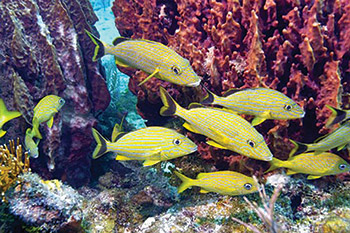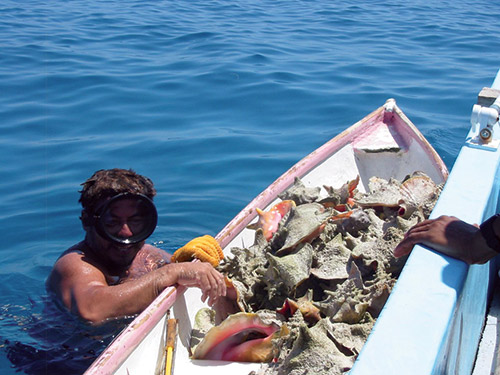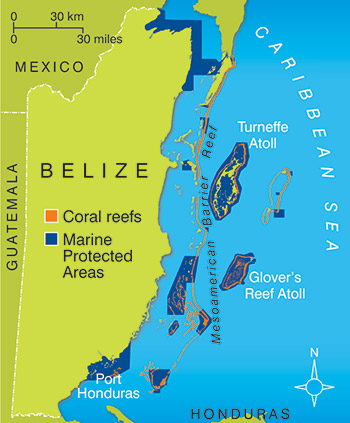Help us restore Belize’s stunning coral reef system
We’re working to save the Mesoamerican Reef, the world’s second largest
 Tessa Dowell, ReefNews Inc.
Tessa Dowell, ReefNews Inc.
Many Belizean fishermen say they now work an entire season to catch the same amount of lobster they once landed in just a week.
The stunning Mesoamerican Reef is the largest barrier reef in the Atlantic Ocean, stretching for nearly 600 miles off Belize, Guatemala, Honduras and Mexico.
Coastal communities depend on the reef and its fisheries for food and income, but today both are in significant decline due to overfishing, coastal development and climate change.
To solve the problem, EDF is using a groundbreaking approach that could serve as a key model for putting coastal fisheries throughout the developing world on a sustainable path.
Read about our work below, and then help us solve the problem by donating today.
What’s gone wrong with the reef?
Belize’s fisheries are in serious decline and have been for decades. Fisheries there have traditionally been “open access”—meaning nearly anyone could get a fishing license and catch unlimited amounts.
As more people have turned to fishing to support themselves, it has put unsustainable pressure on economically important fisheries.
Many fishermen say they now work an entire season to catch the same amount of lobster they once landed in a week. Belizean conch are also threatened by overfishing. This, in turn, has put enomous pressure on the entire reef system.

Yellow grunts are just one of hundreds of fish species found at the reef. The largest grouping of whale sharks also gather at the reef.
How we’re restoring the reef
EDF has been working in Belize since 2009 to restore fisheries to health and abundance. Building on the strong partnerships we forged with Belizean fishermen, the government and local NGOs, in 2011 we launched an innovative fisheries management system that combines marine reserves with catch shares (called managed access in Belize).
We still have a last chance in Belize. Catch shares is that option.
Sonny GarbuttBelizean fisherman
This approach is already showing great promise as a way to help rebuild lobster and conch populations, increase fishermen’s profits, and curb illegal fishing.
We are beginning with pilot projects in two heavily fished locations, and at the Belize government’s request, have already begun planning a national expansion to all lobster and conch fisheries.

The conch catch has fallen 42 percent since the 1970s. (Photo credit: Larry Epstein/EDF)
Rewarding fishermen for being good stewards
The centerpiece of the new management system is called catch shares, a system of rights, responsibilities, and rewards that gives fishermen a financial incentive to fish more carefully and protect marine habitat—an incentive absent until recently.
Sustainable, science-based catch limits are set for commercially important species, and fishermen receive access rights to specific areas.
The majority of fishermen at pilot sites are complying with size limits and seasonal fishery closures and submitting all their catch data. This valuable information will help managers monitor fishery health and set ideal catch limits.
Launching the new model with our partners
The transformation in Belize has grown from collaborations that EDF worked for years to achieve.
With the Belize Fisheries Department, Toledo Institute for Development and Environment, and Wildlife Conservation Society, EDF is now launching the nation’s first combined catch shares-marine reserves system in two vital fishing grounds—Glover’s Reef Marine Reserve and Port Honduras Marine Reserve—using a design that all stakeholders helped create.
Several important components of the system are already in place; it will be fully operational by the end of 2013.

EDF is launching the a combined catch shares-marine reserves system in two vital fishing grounds, Glover’s Reef Marine Reserve and Port Honduras Marine Reserve.
Under the new system, Belizean fishermen are for the first time actively participating in fisheries management—monitoring their catch to improve information on fishery health, assisting in enforcement, and verifying licenses.
As EDF helps build their capacity, fishermen are emerging as strong marine stewards. Their leadership is essential to successful small-scale fishery management because governments in developing nations often lack adequate resources.
Next steps: Beyond Belize
With your help, EDF will use our success to spread catch shares to the entire Mesoamerican Reef, and to other developing countries where limited governance and fisheries data are common problems.